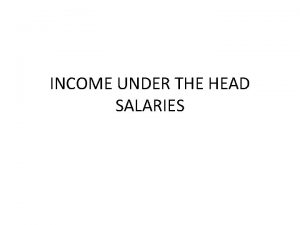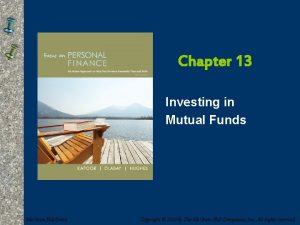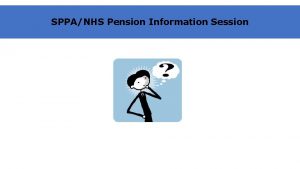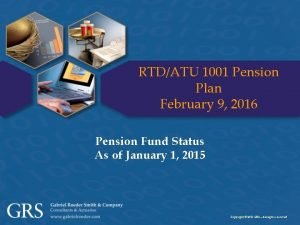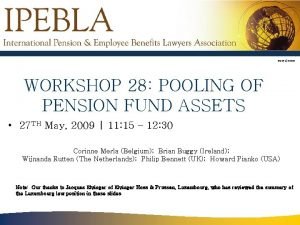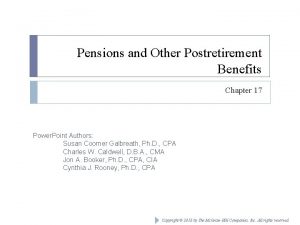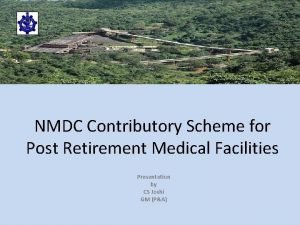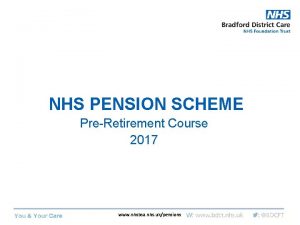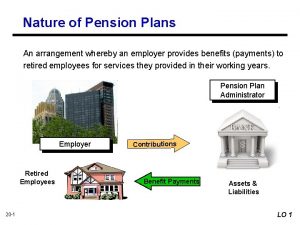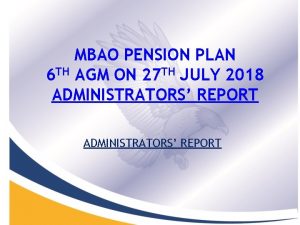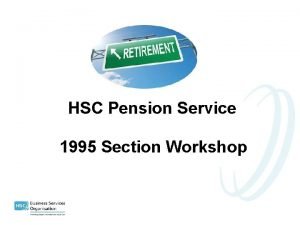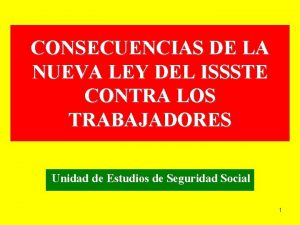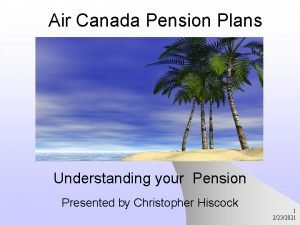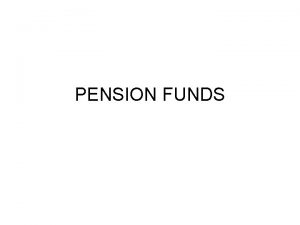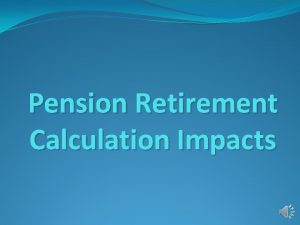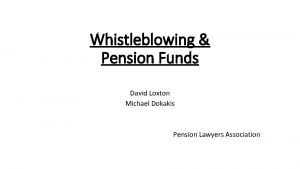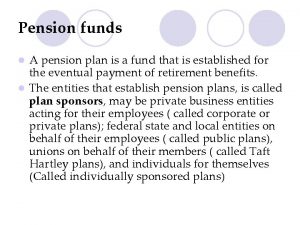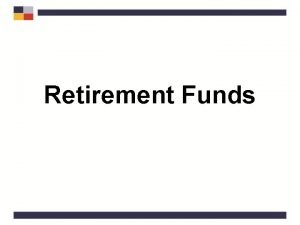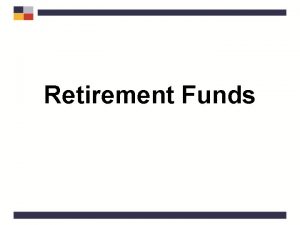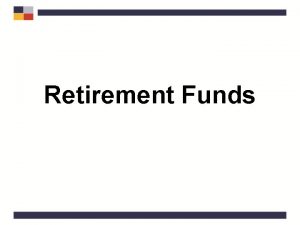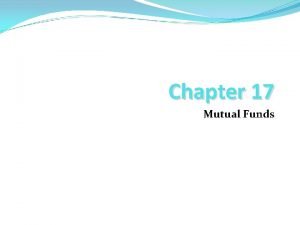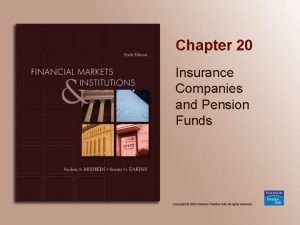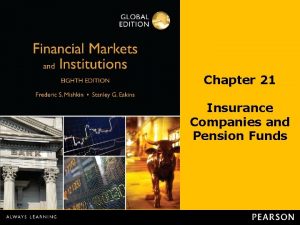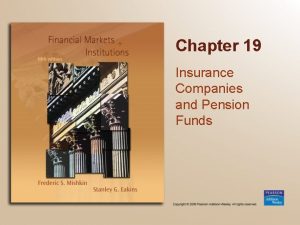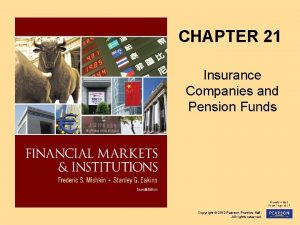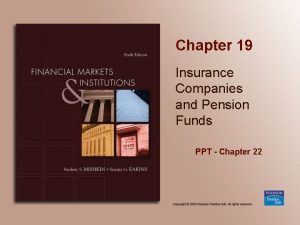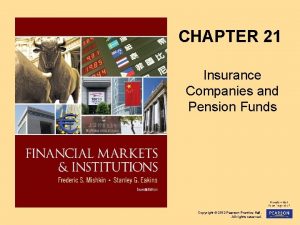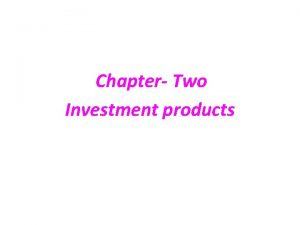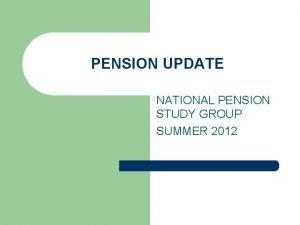Chapter 18 Pension Funds Chapter Outline Pension Funds




















- Slides: 20

Chapter 18 Pension Funds

Chapter Outline Pension Funds Defined: Chapter Overview Size, Structure and Composition of the Industry Financial Asset Investments and Recent Trends Regulation of Pension Funds Global Issues

Definition Similar to life insurance and MF companies Unique feature… Over 700, 000 pension funds exist today. In 2004 U. S. households had about 26. 2% of their financial assets invested in pension funds. Private pension funds Public pension funds Pension fund assets in 2004 were $9, 637. 8 billion, and private pension funds comprised 67. 4% of the total

Size, Structure and Composition of the Industry Insured Versus Noninsured Pension Funds: Insured pension plans Noninsured pension plans

Defined Benefit Versus Defined Contribution Pension Funds Defined Benefit Plans: ice Flat benefit Career-Average Final-Pay Formula

Example An employee works 20 years for a firm. His average salary over his entire career with the firm was $65, 000. His average salary over the last five years was $75, 000. Annual retirement benefit for various defined benefit plans: • Flat benefit of $2, 000 per year worked: $2, 000 20 years = $40, 000 • Career average, flat percentage of 60% of average salary: $65, 000 0. 60 = $39, 000 • Career average, flat percentage amount of 4% of average salary per year of service: $65, 000 0. 04 20 years = $52, 000 • Final pay: A flat percentage amount of 4% of the last five years of salary adjusted for years of service: $75, 000 0. 04 20 years = $60, 000

Defined benefit plans may be Overfunded or fully funded Underfunded. Unfunded minimum funding requirements

Defined Contribution: shifts the risk of poor investment earnings onto the covered employees.

Private Pension Funds Why one should not count on Social Security as the sole source of retirement income

Example: 401 (k) plan the company supplements your investment by contributing a fixed percentage of whatever the employee pays in to the plan. The maximum employer contribution has been 25% of the employee’s salary or $14, 000 per year, whichever is less. The maximum total contribution is the lesser of $41, 000 or 100% of compensation All contributions are TAX-DEDUCTIBLE, and all interest earned accrues TAX FREE until withdrawal

Find the level of annual contribution to a 401(k) plan that would be needed to generate a retirement benefit equal to the $60, 000 per year retirement benefit of the final pay plan given the following information: The employer matches by paying 40% of the first 6% of the employee’s contributions. The employee expects to earn 12% per year on all funds invested. The employee has 20 years of work remaining and will live 25 years after retirement. Solution: Step 1: Required PV at retirement age = = $470, 588 Step 2: Required annual contribution to the plan: ; Total Contribution = $6, 531 Assuming this amount is not more than 6%, the employer pays 40% of the employee’s contribution. $6, 531 = (0. 40 employee contribution) + employee contribution, or the employee’s required annual contribution is $4, 665 and the employer contributes $1, 866. effects of inflation on purchasing power

The effect of the rate of return on employee’s required contribution: If the plan earns only 9% the required annual employee’s contribution is $8, 228. A major equity component is often needed in retirement portfolios to get the required contributions down to a reasonable level

The effect of work time on employee’s required contribution: If the plan earns 12% but the employee has only 15 years of work time remaining the required annual employee’s contribution is $9, 016. You are encouraged to begin funding your retirement as soon as you graduate.

IRA: Keogh accounts A money purchase plan A profit sharing plan

Public Pension Funds Proposals have been made to shore up the Social Security fund

Financial Asset Investments and Recent Trends Private Pension Funds Major assets: Corporate equities Mutual fund shares Treasury and agency securities Corporate and foreign bonds 2002 2004 45. 75% 38. 03% 15. 88% 26. 41% 8. 16% 7. 49% 8. 05% 7. 45% In 2004 defined benefit plans held 39. 76% of their assets in equity and 11. 38% in mutual funds for a total of 51. 14%. Defined contribution plans held 36. 83% in equities and 36. 74% in mutual funds for a total of 73. 57%.

Public (State & Local) Pension Funds Major assets include 2002 2004 Corporate equities 55. 99% 58. 13% Treasury and agency securities 17. 82% 14. 75% Corporate and foreign bonds 15. 72% 16. 08% Since 2002, investment in equities is up slightly. public pension funds, more fixed incomes Over the longer term, investment in equities is much higher than in the past, but down from 65. 7% in 1999. Likewise, investments in long term fixed incomes have increased from their 1999 levels of 12. 4% and 9. 8% respectively Social Security contributions are invested in Treasuries.

Regulation of Pension Funds The Employee Retirement Income Security Act (ERISA

Global Issues Pension plans across the European Union (EU) vary. Funding levels of plans vary from country to country The EU would like to encourage standardization In general one can classify pension plans as to whether the link between the amount paid in and the benefits received is weak or strong

Link between payments & benefits Weak France Germany Strong England, Sweden, Italy, Chile Italy Chile
 Salary means
Salary means Topic sentence sandwich
Topic sentence sandwich Chapter 13 investing in mutual funds
Chapter 13 investing in mutual funds Sppa pension
Sppa pension Rtd/atu 1001 pension plan
Rtd/atu 1001 pension plan Pension master trust
Pension master trust Projected benefit obligation
Projected benefit obligation Nmdc employees pension scheme
Nmdc employees pension scheme Www.totalrewardstatements.nhs.uk
Www.totalrewardstatements.nhs.uk Jim1 nhs monthly
Jim1 nhs monthly Nhs pension examples
Nhs pension examples Defined contribution journal entry
Defined contribution journal entry Mbao pension plan
Mbao pension plan Tabla para jubilarse en el issste
Tabla para jubilarse en el issste Hscpensions
Hscpensions Hsc pensions calculator
Hsc pensions calculator Kpa pension föräldramöte
Kpa pension föräldramöte Tabla pension issste
Tabla pension issste Max cpp payment 2021
Max cpp payment 2021 Aviva my future focus growth
Aviva my future focus growth Prms ntpc
Prms ntpc
